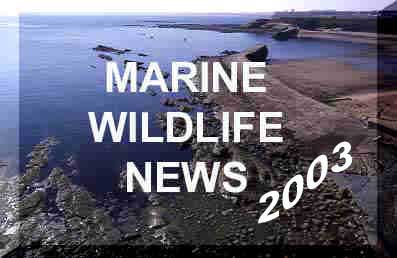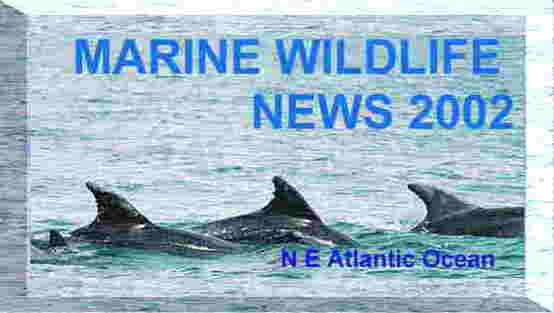
|
|
|
|
|
(BMLSS *** Site) |
|
|
|
Norwegian Marine*** |
|
L-I-N-K-S to Other Sites (Click on Text) |
|
Smart Group |
 |
|
|
|
|
|
|
 .
.
Reports of marine wildlife from all around the British Isles, with pollution incidents and conservation initiatives as they affect the fauna and flora of the NE Atlantic Ocean.
on Microsoft Internet Explorer (best) or Netscape
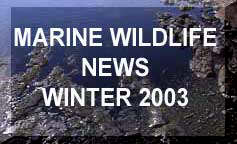 |
 |
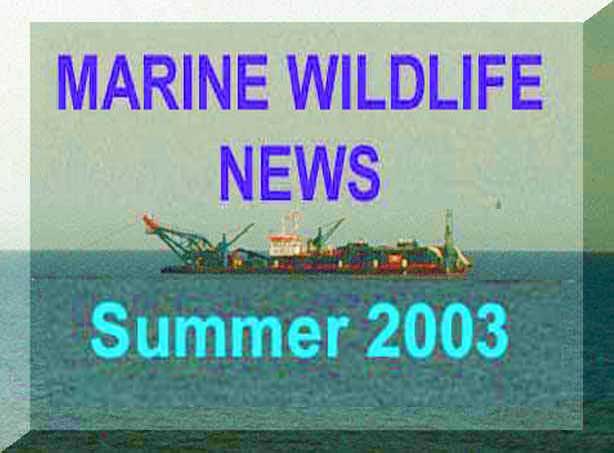 |
 |
LATEST NEWS: WINTER 2003
- 28
March 2003
An American Scoter, Melanitta nigra, a vagrant sea bird from the western side of the North Atlantic turned up on the coast of Denmark at Blåvands Huk.
27
March 2003
The
European Union transport ministers endorsed a ban
on old single-hull tankers carrying heavy fuel oil, in an effort to prevent
oil slicks like the Prestige disaster
which sank off Spain in November 2002. Once confirmed by the European Parliament
(possibly July 2003), the law will immediately ban most single-hull ships
older than 23 years of age from carrying the highly polluting forms of
oil from calling at EU ports, a EU Transport Commissioner Loyola de Palacio
said.
14
March 2003
I have photographed a Giant
Goby, Gobius cobitis, at Pendennis
Point, Falmouth, Cornwall. This protected species is rare on the northern
coasts of the English Channel.
Giant
Goby Image (Link)
More
Information on the Giant Goby
BMLSS
Gobies
21
February 2003
The Sea Lamprey was 51.8 grams in weight and 267 mm in length. This jawless fish is still reasonably common but there are few records from the Channel Islands. In recent past they have been eaten.
Channel Islands Wildlife Discussion Forum
BMLSS Lamprey page
c.
20 February 2003
Angler
Val
Fletcher struggled for 40 minutes to reel
a unique shore capture of the deep oceanic fish known as the Oarfish,
or Ribbonfish, Regalecus glesne, off
the north-east coast of England at Anchor Hole, Skinningrove, Cleveland.
This rare fish caught on a squid bait came as a bit of a shock, even scary,
as first the head and then the whole length of its 3.3 metres emerged from
the sea. This elongate silvery fish, with red fins weighed in at 63.5 kg,
which actually meant it was rather a small one for arguably the largest,
certainly the longest bony fish in the mostly deep oceans (found down to
1000 metres) attaining a normal length of 7 metres and a maximum of over
11 metres, and a maximum weight of 272 kg.
So
unusual was this discovery that it ranks as perhaps the most unusual of
all records on these news pages.
Link
to Photograph
An
alternative story is that the Oarfish became trapped in a net and was brought
ashore dead. This seems a more likely occurrence.
The
last record of an Oarfish washed up on the British coasts goes back to
1981, again on a North Sea coast at Whitby, north Yorkshire. There are
only two known photographs of an Oarfish in the wild, which shows that
its main method of swimming is vertical, propelled by its dorsal fin. However,
there are reports of young Oarfish swimming below the surface in a sinuous
manner.
The
Oarfish has a wide distribution in all the deep oceans with most records
from the tropics. It is one of two fish in the family Regalecidae.
The similar Ribbonfishes are in the family Trachipteridae.
I
have serious doubts about the authenticity of this record and it is thought
that it could only be a Dealfish
(Ribbonfish
family),
Trachipterus
arcticus.
Original
Report and Discussion (Link)
Times
Report
Fishbase
Entry
16
February 2003
A
117 cm pup long of a Bluntnose Sixgill
Shark, Hexanchus griseus,
was landed at Mevagissey, south Cornwall. The shark weighed 6.3 kg before
gutting. The Bluntnose Sixgill Shark
is principally a deep water species, usually found offshore and near the
bottom at depths of up to 1,800 metres. Young specimens can however
occasionally be found inshore in cold water at depths as shallow as 25
- 50 metres, especially near rocky coasts or islands where deep water occurs
close by. The shark was caught by a small day boat FV
Soft Shadow in a bottom set net (gill net).
These boats do not usually fish more than six to ten miles offshore where
the maximum depth would be 65 metres.
Sixgill
Shark pups measure 65 cm - 70 cm at birth
and can grow up to at least 4.8 metres (over 15 ft) long. This grey coloured
sharks is unusual in that compared with most species of shark, they have
an extra pair of gills. Females are thought to have 22 - 108 pups per litter.
Full
Report
- 11
February 2003
A dead Sperm Whale, Physeter macrocephalus, has been found washed ashore just north of the Shore Station at Burrafirth, north Unst, the most northerly island in the Shetland Isles. It is relatively fresh, at least by the standards set by previous corpses, which are usually no more than lumps of blubber.
13
February 2003
One
adult and one juvenile Humpback
Whale, Megaptera
novaengliae, are seen 100 metres off Cove, near Aberdeen, north east
Scotland. They swam slowly north past Girdleness breaching about one mile
offshore in Aberdeen Bay. This large whale is
regularly seen around the
Shetland
Isles but rarely ventures further south.
30 January 2003
From around 3:00 pm to 4.30 pm, I witnessed a very large pod of dolphins swimming eastwards up the English Channel past Polperro, Cornwall. It was impossible, even through my telescope, to firmly identify the species, but there were a mix of (probably) Common Dolphins, Delphinus delphis, and Porpoises, Phocoena phocoena. They were leaping from the water from about a half mile from the coast to the horizon, and spread over the four miles or so that I can see from my window. Numbers must have been well over a thousand. A fantastic sight to witness, and one I have not seen before in my nine years in Polperro.
BMLSS Cetacea
29
January 2003
The
level of oil pollution on Belgium's west coast worsened as more and bigger
oil slicks from the sunken vessel Tricolor washed ashore and strong
winds hampered clean-up operations. A spokeswoman with a Belgian North
Sea ecosystem management institute, BMM, said the situation at Zeebrugge
and Blankenberge had worsened since yesterday and oil slicks several square
metres in size were being washed ashore. The Knokke-Heist Council also
reported that oil clumps had polluted the beach at Heist, but it was not
yet certain whether the oil had infiltrated the De Baai Nature Reserve.
Oil has also washed ashore at Bredene, but the town's Mayor, Willy Vanhooren,
said the situation was not yet an environmental disaster.
Oiled Birds on Belgian beaches
 28
January 2003
28
January 2003
Thousands
of By-the-Wind Sailor,
Velella
velella, are discovered washed up, alive or very freshly dead,
on Perranporth Beach, Cornwall, together with the Violet
Snail, Janthina janthina, (two
shells) that preys on Velella. This gastropod
is rarely recorded in British seas even when there are large numbers of
Velella
stranded. It is always worth looking for this attractive and fragile shell.
Exceptionally,
between 100 and 200 of the small jellyfish called Pelagia
noctiluca, the Mauve Stinger or
'Nightlight' jellyfish were also discovered.
These swarms seems to occur about every five or ten years, and is easily
recognised by the pustules that cover the small (rarely more that 75 mm
across) dome or umbrella.
The
cuttlebones
of all three species of large
British cuttlefish, Sepia,
and
a
Spirula
(a tiny mesopelagic cephalopod) shell were also found in the squally conditions
on the shore.
Rory
Goodall has also found large numbers of Velella,
on Porthmeor Beach, St Ives, Cornwall.
via the Marine Wildlife of the North-east Atlantic Ocean Group
BMLSS Cuttlefish
BMLSS Molluscs
24
January 2003
A
14 metre long male Sperm
Whale, Physeter macrocephalus,
beached at the mouth of the River Ouse, near Kings Lynn, Norfolk, and died
as a result of the stranding. The dead whale was present on Brest Sands
in the Wash the following day when Rob
Deaville from the Natural History Museum performed a post-mortem. The
ultimate cause of the live stranding could not be determined but the animal
appeared to be reasonably aged (very worn teeth) so this may have played
a factor. This large whale is rarely stranded on English North Sea coasts,
with the first of the 20th century in 1986
and four records thereafter.
Sperm Whale (southern North Sea, stranded dead) 2000
A four metre long Minke Whale, Balaenoptera acutorostrata, is washed up dead on Shanklin beach on the east coast of the Isle of Wight. This could be the same whale that was spotted briefly stranded in Portland Harbour last year.
23
- 28 January 2003
Over
a period of five days, at least 2,000 oiled
birds have washed ashore on Belgian beaches,
especially between De Panne and Ostend and more are coming in.
The
majority of the birds are Guillemots,
but more than 100 Razorbills
were also washed ashore.
BMLSS Sea Birds
Oiled Birds
13
January 2003
A
live Green Turtle, Chelonia
mydas, was stranded on the west coast
of Guernsey (Channel Islands) in the afternoon.
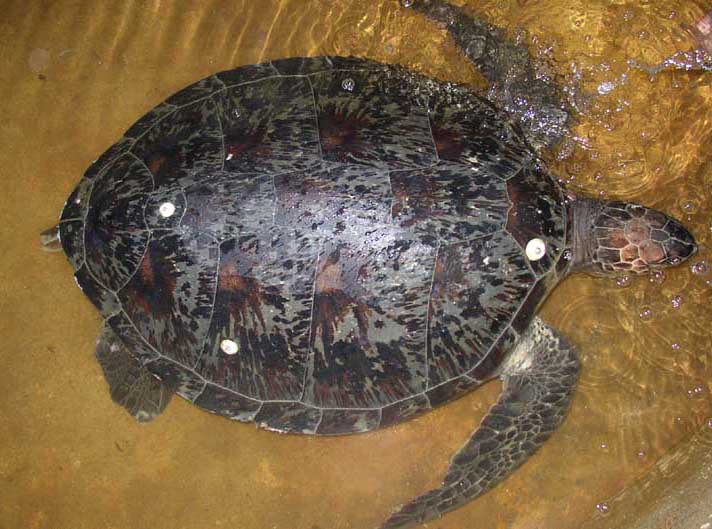 Elliot
Green, was playing
football with his young son, discovered the
turtle on Saline Beach and reported it to the Guernsey Society for the
Protection of Cruelty to Animals (GSPCA).
Geoff George and Yvonne Chauvel (in the photograph) collected
the turtle, and after it had been treated by veterinarian John
Knight, transferred it to the Guernsey
Aquarium at St. Peter Port until arrangements can be made to release
it into the sea at a suitable location (preferably warm water). The
curved carapace length of the turtle is 75 cm and the curved carapace width
is 68 cm. This turtle inhabits tropical seas including the Atlantic coast
of Spain and the Mediterranean Sea. This turtle is only very rarely recorded
in British seas. This is the seventh
confirmed record from around Britain, although there may be an eighth
record from Essex.
Elliot
Green, was playing
football with his young son, discovered the
turtle on Saline Beach and reported it to the Guernsey Society for the
Protection of Cruelty to Animals (GSPCA).
Geoff George and Yvonne Chauvel (in the photograph) collected
the turtle, and after it had been treated by veterinarian John
Knight, transferred it to the Guernsey
Aquarium at St. Peter Port until arrangements can be made to release
it into the sea at a suitable location (preferably warm water). The
curved carapace length of the turtle is 75 cm and the curved carapace width
is 68 cm. This turtle inhabits tropical seas including the Atlantic coast
of Spain and the Mediterranean Sea. This turtle is only very rarely recorded
in British seas. This is the seventh
confirmed record from around Britain, although there may be an eighth
record from Essex.
The
white spots are a species of turtle barnacle, which may have not been recorded
before on the British list of marine (barnacle)
species (MCS Directory).
Green Turtle Information Page
BMLSS Turtles
UK Marine Mammal and Marine Turtle Strandings Project
EuroTurtle
BMLSS Barnacles
Barnacles (notes)
Channel Islands Discussion
11 January 2003

A large jellyfish weighing an estimated 15 kg was washed up at Lepe Country Park on the Solent coast in Hampshire (SZ 459 985). The excellent photograph of the underside confirmed this as the first reported specimen of Rhizostoma octopus for 2003.
9 January
2003
Already
32 dead
cetaceans, have been washed up on the
shores of south Cornwall this year, so that the recorders and helpers including
David
Ball of the Silver
Dolphin Conservation and Diving Centre at Porthleven, Cornwall can
hardly keep track of the 'tide' of carcasses. The dolphins have been in
the sea for long enough for them to start to decompose. They are all tagged
with with cable ties around the tail, so that if they wash out and re-beach,
they can be identified. At least some of them have probably been caught
in fishing nets.
By
18
January 2003 the number had risen to 55. Most
have been Common Dolphins (Delphinus
delphis), one was a Striped Dolphin (Stenella
coeruleoalba),
Harbour Porpoises,
(Phocoena phocoena), number about 10, and several carcasses were
too decayed to be identified.
By
29
January 2003,
David
Ball advised me that the number had increased to 74, rising to 77 by
30
January 2003.
BMLSS Cetacea
4 January 2003
Fishermen aboard the Polperro (south Cornwall) bottom trawler "Girl Jane" reported an extraordinary dolphin sighting whilst fishing some 13 miles west of Plymouth, and about two miles offshore, they encountered a pod of leaping dolphins estimated to be "many hundreds", perhaps a thousand. The species was not identified. At the same time they received a call on the radio from a sister ship fishing 10 miles east off Rame Head that they were surrounded by at least two hundred dolphins (obviously a different pod).
On 17 January 2003 Polperro trawler "Girl Jane" (again) reported another huge pod of dolphins and porpoises, whilst shooting nets some 20 miles off Rame Head. Trawler "Cazadora", three miles or so away at the time also recorded dolphins. In both cases the number reported was "hundreds". Also, the Plymouth mackerel boats off Eddystone reef stopped fishing as they were catching dolphins rather than fish.
1
January 2003
My
dog discovered a 25 cm (10 in) long Triggerfish,
Balistes
capriscus, are washed up dead on the beach between Seascale and
Sellafield (Cumbria). I recognised the body shape and the shell crunching
type of teeth in the book.
BMLSS Triggerfish
27 December 2002
A Minke
Whale, Balaenoptera acutorostrata,
is
spotted just before midday stranded on some rocks in Portland Harbour,
Dorset. The coastguards were called and they managed to push the whale
back into the water and it spent the rest of the day swimming around the
large natural harbour, but it has yet to be coaxed back out to the open
sea. This species of whale is rarely seen in the shallower parts
of the English Channel.
BBC
News Report
Corrected
Report by Clive Martin (Biscay Dolphin Research Programme)
BMLSS
Cetacea
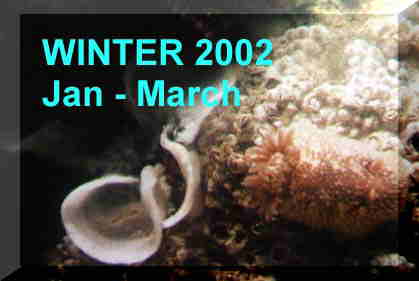 |
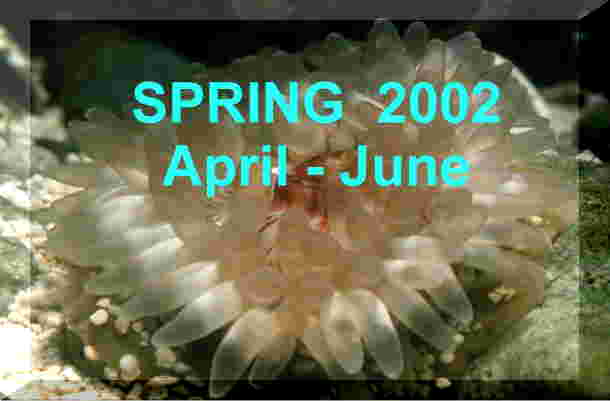 |
 |
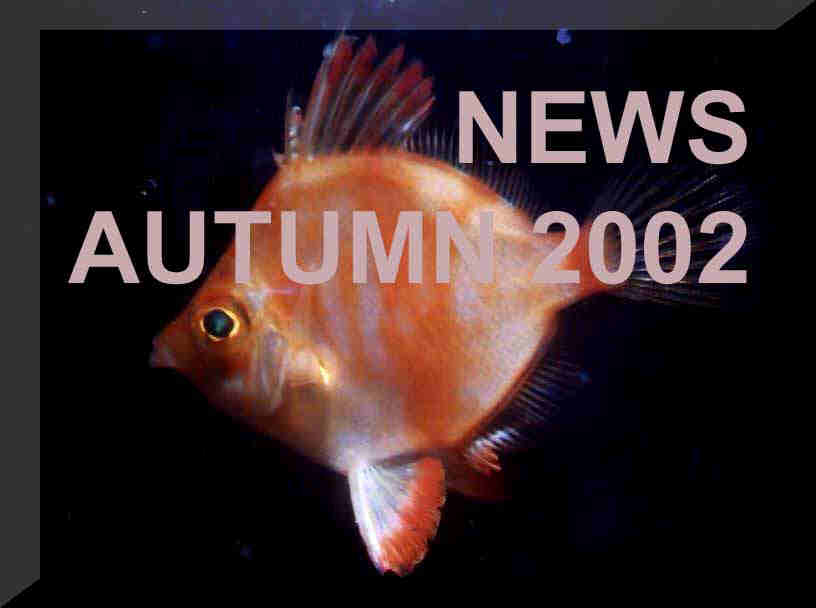 |
FOR EARLIER REPORTS CLICK ON THE BUTTON BELOW

The Marine Wildlife of the NE Atlantic Forum commences.
PLEASE JOIN

MARINE WILDLIFE of the NE ATLANTIC EFORUM PAGE (LINK TO)
News 2002
News 2001
News 2000
News 1999
|
Use these links if your are familiar with the scientific classifications of marine life |
The BMLSS (England) site commenced on 1 January 1997.
|
|
 |
 |
Andy Horton, Webmaster
|
|
|
|
|
|
Membership Form |
News 2001 News 2000 |
